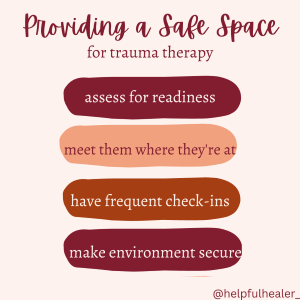*DISCLAIMER: Please do not engage in trauma therapy if you have not received training or supervision to do so. These are a few helpful tips for those who are ready to practice trauma therapy or have done so already. The most importance thing is helping our clients feel safe in the therapeutic space with us. Also sometimes trauma can be disclosed later on in treatment you were not aware of before. It can catch us off guard and these tips can be useful in the moment.
- ALWAYS assess client’s readiness for trauma therapy. We never want to be in the position of pushing our students into trauma therapy. Parents and caregivers can give you a heads up before starting treatment wanting you to address the trauma, but remember the student is your client first and foremost. The best way to assess for readiness is when a student discloses to you their trauma, it is an indication they feel safe enough to talk about aspects if not all of the trauma with you. If they do not readily disclose the trauma, it means a therapeutic relationship needs to be further established.
- Do not rush the trauma therapy process. I am certified in Trauma-Focused Cognitive Behavioral Therapy and there is a structured process to facilitate therapy for trauma. I used to think I needed to go through all the steps week after week but that is definitely not the case. It is more important to be attuned to where your student is at. It is okay to remain at a certain place in the trauma therapy for weeks or months at a time.
- Take frequent breaks. During the session time you have with your client, taking frequent breaks throughout to check-in and practice relaxation strategies if very important. Sometimes clients can feel overwhelmed but not be confident enough to stop the next activity/topic you have planned. It is on you to facilitate high doses of check-ins. I use a stoplight in trauma therapy to determine whether a client is ready to continue or not. Red meaning a full stop and doing something different for the session. Yellow is needing a break and this is where it is good to practice grounding techniques. Green means good to keep going.
- Be aware of telehealth surroundings. As many of us are on telehealth these days, if you are facilitating trauma therapy ensure the client’s surroundings are secure and safe for them. If they are in a more public room where people are walking in and out, they will not feel safe to talk openly about the trauma. Try to make the space more secure by relocating or putting sounds and music on in the background to drown out their talking from others in the vicinity. If their space is not conducive to trauma therapy it is okay to make a referral to a in-person therapist who has an office space for them.

